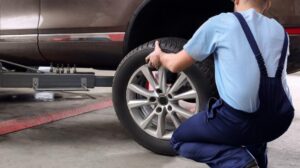“`html
Introduction to Rough Idle in Cars
When discussing automotive performance, the term “rough idle” refers to an irregular or unstable engine idle. This condition manifests itself through noticeable symptoms such as shaking or vibrations felt within the vehicle, and a fluctuating RPM gauge. Drivers might observe their car’s engine running unevenly when the vehicle is stationary, with the RPM needle wavering unpredictably. These symptoms can be unsettling and are often indicative of underlying mechanical issues.
Understanding a rough idle requires recognizing its potential implications. At its core, a rough idle suggests that the engine is not running as smoothly as it should. This can be due to a variety of factors, ranging from minor to severe, each affecting the engine’s performance and efficiency. While the vehicle may still be operable, ignoring these signs can lead to more significant problems down the line. A rough idle can signal early stages of engine trouble, making it crucial to address the issue promptly to avoid exacerbating the problem.
Addressing a rough idle is essential not only for maintaining optimal engine performance but also for ensuring fuel efficiency and reducing wear and tear on engine components. Prolonged operation under these conditions can lead to more extensive damage, potentially resulting in costly repairs. Therefore, understanding the symptoms and taking timely action can prevent further complications and maintain the vehicle’s longevity.
This introduction sets the stage for a deeper dive into the causes and solutions for a rough idle. By comprehending what constitutes a rough idle and recognizing the importance of addressing it, drivers can be better prepared to maintain their vehicles and ensure a smoother driving experience.
Common Causes of Rough Idle
A rough idle is a symptom that can be attributed to several underlying issues within your vehicle’s engine. Understanding these common causes can help you diagnose and address the problem effectively. Here, we explore some frequent culprits: vacuum leaks, dirty fuel injectors, faulty spark plugs, and issues with the idle air control valve.
Vacuum Leaks
Vacuum leaks occur when there is an unintended gap or crack in the engine’s vacuum system, which causes an imbalance in the air-to-fuel ratio. This imbalance can lead to a rough idle as the engine struggles to maintain a steady RPM. Identifying vacuum leaks can be challenging, but using diagnostic tools like those found at Auto Advisor can assist in pinpointing the exact location of the leak.
Dirty Fuel Injectors
Fuel injectors are responsible for delivering fuel into the engine’s combustion chambers. Over time, they can become clogged with debris and deposits, leading to uneven fuel distribution. This can cause the engine to idle roughly as it tries to compensate for the irregular fuel flow. Regular maintenance and using injector cleaners can help prevent this issue. For more advanced diagnostics, consider tools from Auto Advisor Pro.
Faulty Spark Plugs
Spark plugs play a crucial role in igniting the air-fuel mixture within the engine cylinders. Worn or dirty spark plugs can result in incomplete combustion, causing the engine to idle roughly. Replacing spark plugs at regular intervals is essential for maintaining optimal engine performance. You can find suitable replacements and diagnostic kits at Auto Advisor.
Idle Air Control Valve Issues
The idle air control (IAC) valve regulates the engine’s idle speed by controlling the amount of air entering the engine. If the IAC valve is malfunctioning or clogged, it can lead to an unstable idle. Cleaning or replacing the IAC valve can often resolve this issue. For more information on how to diagnose and address IAC valve problems, visit Auto Advisor Pro.
Addressing these common causes can significantly improve your car’s idle quality and overall performance. Proper diagnostics and timely maintenance are key to ensuring a smooth and efficient engine operation.
Diagnosing and Fixing a Rough Idle
Experiencing a rough idle can be unsettling, but diagnosing and potentially fixing the issue can be manageable with a systematic approach. Start with some basic checks that can often reveal the root cause quickly. Inspecting vacuum hoses for any signs of wear, cracks, or disconnections is a good first step. Damaged or loose hoses can lead to air leaks, which disrupt the engine’s air-fuel mixture, causing a rough idle.
Next, examine the spark plugs. Worn or fouled spark plugs can create misfires, which manifest as a rough idle. If the spark plugs appear dirty or damaged, replacing them with high-quality alternatives is advisable. For those comfortable with more hands-on diagnostics, checking the condition of the spark plug wires and the ignition coil can provide further insights. These components play a crucial role in delivering the necessary spark to ignite the fuel-air mixture.
If the basic checks don’t resolve the issue, more involved diagnostics might be required. Testing the fuel injectors can reveal if they are clogged or malfunctioning. A professional-grade diagnostic tool can help you monitor injector performance and identify any irregularities. Similarly, examining the idle air control valve (IACV) is essential. The IACV regulates the engine’s idle speed, and if it’s dirty or failing, it can cause the engine to idle roughly. Cleaning or replacing a faulty IACV can often smooth out the idle.
For DIY enthusiasts, using high-quality diagnostic tools is crucial. These tools not only provide accurate readings but also help avoid misdiagnosis, saving both time and money. However, if the problem persists or the diagnostics seem too complex, seeking professional help is a wise decision. Mechanics have specialized equipment and expertise to diagnose and fix issues effectively.
In conclusion, diagnosing and fixing a rough idle involves a series of methodical steps, from simple inspections to more detailed diagnostics. Whether you choose to tackle the issue yourself or consult a professional, using high-quality parts and tools ensures a reliable and long-lasting fix.
Preventive Measures to Avoid Rough Idle
Maintaining a smooth and consistent idle in your vehicle is crucial for optimal engine performance and efficiency. Implementing regular maintenance practices can go a long way in preventing rough idle issues. One essential practice is the periodic cleaning of fuel injectors. Over time, fuel injectors can become clogged with deposits, which can disrupt the fuel flow and cause the engine to run unevenly. Utilizing fuel injector cleaner or having them professionally serviced can ensure they function correctly.
Another key preventive measure is the timely replacement of spark plugs. Spark plugs play a critical role in igniting the air-fuel mixture in the engine’s cylinders. Worn or fouled spark plugs can lead to misfires and rough idling. It’s recommended to adhere to your vehicle manufacturer’s guidelines for spark plug replacement intervals to maintain smooth engine operation.
Regular inspections of vacuum hoses are also vital. Vacuum hoses can develop cracks or leaks over time, leading to air intake issues and an unstable idle. Routine checks and replacements of these hoses can help prevent such problems. Additionally, ensure that the air filter is clean and in good condition, as a restricted air filter can affect the engine’s idle quality.
Routine engine tune-ups are fundamental in maintaining overall engine health. During a tune-up, various engine components, such as the ignition system, fuel system, and emission control systems, are inspected and serviced. This comprehensive check-up helps identify potential issues before they escalate into severe problems, ensuring the engine runs smoothly.
For reliable advice and quality automotive services, consider using trusted sources like Auto Advisor and Auto Advisor Pro. These platforms offer expert guidance and resources to help you maintain your vehicle in top condition.





